The Charlie Hebdo murders, and the subsequent shoot outs and man hunts, have led to an unprecedented discussion over the role of satire, art and cartooning. It is also, of course, a horrific event that will change tactics against terrorism within France and elsewhere. Much has been written, and while it has often seemed the occasion for airing out whatever personal feelings many commenters already had, there also been much that is thoughtful and worth examining. The “Je suis Charlie” show of solidarity remains controversial and widespread—at the Golden Globes Jared Leto gave a clumsy reading while George Clooney gave it a more nuanced shout out, if that’s possible.
People are struggling to deal with this, and as they struggle they show their work on the internet. And here’s some of it.
§ in France, more than a million people marched to protest terrorism.
Responding to terrorist strikes that killed 17 people in France and riveted worldwide attention, Jews, Muslims, Christians, atheists and people of all races, ages and political stripes swarmed central Paris beneath a bright blue sky, calling for peace and an end to violent extremism.The Interior Ministry described the demonstration as the largest in modern French history, with as many as 1.6 million people. Many waved the tricolor French flag and brandished pens in raised fists to commemorate those killed Wednesday in an attack on the satirical newspaper Charlie Hebdo, as well as four others killed at a Jewish supermarket on Friday. Thousands hoisted black and white signs bearing three words that have ricocheted through social media as a slogan of unity and defiance: “Je suis Charlie.”
§ Probably the most seen cartoonist reaction was R. Crumb’s, above, (followed by Aline Kominsky-Crumb’s).
And, in a perfect example of the long-simmering axe grinding I alluded to above, Crumb used his cartoon as the chance to rag on animator Ralph Bakshi, whose cartoon adaptation of Fritz the Cat back in the day did not please Crumb. Anyway, this was followed by a long interview with Crumb in the Observer. MUST READ!
We don’t have a context for this tradition here, merciless, political satire. One thing I keep noticing is commentators here are pointing out that the cartoons were very offensive and insulting. It’s as if we don’t understand that was by design. Very intentionally offensive, and very clear about why that couldn’t be compromised. That’s the part we don’t get, as Americans. It’s like, “Why did they have to be so mean?” It’s a French thing, yeah, and they value that very highly here, which is why there’s like a huge amount of sympathy for the killing of those guys, you know, huge demonstrations and crowds in Paris – people holding up signs that say, “Je suis Charlie.” Even here in the village where I live, we had a demonstration yesterday out in front of the town hall. About 30 people showed up and held up “Je suis Charlie” signs. Were you there? Yeah, I went to it, sure. Since I’m the village cartoonist, I had to go. [Laughs.]
Related, Crumb’s old publisher Ron Turner, stands up for satire’s right to be offensive.
§ For a reaction even closer to the scene, sometime Hebdo contributor Dutch cartoonist Willem came out with a very colorful reaction, namely “We vomit on all these people who suddenly say they are our friends.”
“We have a lot of new friends, like the pope, Queen Elizabeth and (Russian President Vladimir) Putin. It really makes me laugh,” Bernard Holtrop, whose pen name is Willem, told the Dutch centre-left daily Volkskrant in an interview published Saturday. France’s far-right National Front leader “Marine Le Pen is delighted when the Islamists start shooting all over the place,” said Willem, 73, a longtime Paris resident who also draws for the French leftist daily Liberation.
The 72 year old Willem added “I never come to the editorial meetings because I don’t like them. I guess that saved my life.”
Personal note: It’s encouraging to see an old guy like Willem defiant and subversive down the wire. He was the Grand Prix winner for the Angouleme festival I attended last year, and, he’s quite a character.
§ Current Charlie Hebdo staffer Luz was late to the editorial meeting that day and that saved his life. He was interviewed by a French paper.
When I started drawing, I always thought we were safe, as we were drawing pseudo Mickey Mouse. Now, after the deaths, the shoot outs, the violence, everything has changed. All eyes are on us, we’ve become a symbol, just like our cartoons. Humanité headlined “Liberty has been assassinated” above the cover I did on Houellebecq that, even if there’s some substance there, is a quip at Houellebecq. A huge symbolic weight, that doesn’t exist in our cartoons and is somewhat beyond us, has been put on our shoulders. I’m one amongst many who’s finding that difficult.
§ Cynthia Rose was visiting Paris last week and has a moving account of her experiences.
§ Joe Sacco’s cartoon in the Guardian warning against the dangers of reinforcing bigotry through satire has been widely seen and quoted. It’s a powerful argument against the anything goes attitude that Charlie Hebdo engaged in—an attitude which make many uncomfortable with the “Je suis Charlie” line.
§ Ruben Bolling responded with a call for context:
But I was especially disappointed in the final three panels, in which he asks us to consider why Muslims can’t “laugh off a mere image.” Well, just as it’s hard for us to know the full editorial intent of Charlie Hebdo from a few re-published out-of-context cartoons, it’s even more difficult to know whether or not Muslims are unable to laugh off these mere images.
It was not the Muslim community that killed those twelve people, it was two gunmen. I don’t know how outraged Muslims were at Charlie Hebdo, but I would imagine their responses would be as greatly varied as they are irrelevant to the murders.
One thing that has emerged as more views have been aired is that it is difficult for mere bystanders to understand the place that Charlie Hebdo held in French society. Arab satirist Karl Sharro works his way through this at The Atlantic:
The culture-clash interpretation of the horror in Paris transcends political divides in the West. On the right, some claim that Muslims’ beliefs are incompatible with modernity and Western values. On the left, some construe the attack as a retaliation for severe offenses, essentially suggesting that Muslims are incapable of responding rationally to such offenses and that it is therefore best not to provoke them. The latter explanation is dressed up in the language of social justice and marginalization, but is, at its core, a patronizing view of ordinary Muslims and their capacity to advocate for their rights without resorting to nihilistic violence. This outlook also promotes the idea that Muslims and other people of Middle Eastern origin are defined primarily by their religion, which in turn devalues and demeans the attempts of Arab and Middle Eastern secularists to define themselves through varying interpretations of religion or even by challenging religion and its role in public life. By seeking to present religion as a form of cultural identity that should be protected from offense and critique, Western liberals are consequently undermining the very struggles against the authority of inherited institutions through which much of the Western world’s social and political progress was achieved.
§ French satirist Oliver Tourneau has written On Charlie Hebdo: A letter to my British friends which attempts to contextualise Charlie Hebdo for those of us who don’t quite get now it fits in to the very active place of intellectualism in French life and politics. Charlie Hebdo was considered very leftist and PRO diversity…some of its most shocking images were apparently Stephen Colbert-like exaggerations of other trains of thought:
Firstly, a few words on Charlie Hebdo, which was often “analyzed” in the British press on the sole basis, apparently, of a few selected cartoons. It might be worth knowing that the main target of Charlie Hebdo was the Front National and the Le Pen family. Next came crooks of all sorts, including bosses and politicians (incidentally, one of the victims of the shooting was an economist who ran a weekly column on the disasters caused by austerity policies in Greece). Finally, Charlie Hebdo was an opponent of all forms of organized religions, in the old-school anarchist sense: Ni Dieu, ni maître! They ridiculed the pope, orthodox Jews and Muslims in equal measure and with the same biting tone. They took ferocious stances against the bombings of Gaza. Even if their sense of humour was apparently inacceptable to English minds, please take my word for it: it fell well within the French tradition of satire – and after all was only intended for a French audience. It is only by reading or seeing it out of context that some cartoons appear as racist or islamophobic. Charlie Hebdo also continuously denounced the pledge of minorities and campaigned relentlessly for all illegal immigrants to be given permanent right of stay. I hope this helps you understand that if you belong to the radical left, you have lost precious friends and allies.
§ Finally, splitting the difference, here’s an overview called The Problem With #JeSuisCharlie by Chad Parkhill.
§ And Asterix co-creator Albert Uderzu came out of retirement to show his solidarity with eh slain cartoonists:
§ Now, shifting gears into a very alarming direction, it seems that there has been an increase in threats against cartoonists since the murders. Cartoonists Rights has a frightening round-0up:
A newspaper in Germany which had reprinted several of the controversial Charlie Hebdo cartoons was firebombed Sunday January 11 in possible retaliation.
And in Turkey, journalist Pinar Tremblay of Al-Monitor reports of threats referencing the Hebdo killings targeting that country’s cartoonists and satirical magazines. One satirist reports being told to watch the news coverage of Charlie Hebdo’s slain cartoonists “to take a sneak peak at my own future.”
The Istanbul-based satirical magazine Leman, which is planning a tribute issue commemorating its Charlie Hebdo colleagues, received a tweet saying “The number of heads to be taken out in Leman magazine is more than 12.”
§ And there was an ugly incident involving the Israeli newspaper Haaretz:
In the wake of the Charlie Hebdo massacre in Paris last week Haaretz published a daring cartoon juxtaposing journalists* killed in Gaza by Israel during the brutal summer slaughter with the journalists killed at the office of the satirical magazine in Paris. This set off a chain reaction which ultimately led to calls for murdering Haaretz journalists after Ronen Shoval, founder of the neo-Zionist and proto-fascist Im Tirtzu movement, called for an investigation of the newspaper’s editors.
§ While everyone is now a defender of free speech, many calling for it have spotty track records in their own countries.
§ Wrapping this up, Tom Spurgeonhas a round-up of videos related to the killings.
§ And finally, on Tuesday, the New York Comics Symposium will represent a discussion of Charlie Hebdo.
Eddy Portnoy will revisit his 2012 presentation on “Cartoon Provocateurs: the non-existent red lines of Charlie Hebdo,” in light of this week’s deadly attack on the offices of the French satirical weekly. Also, a screening of documentary clips concerning the events surrounding the reprinting a set of 12 cartoons of the Prophet Mohammed that had originally appeared in the Danish newspaper, Jyllands Posten in 2006, in addition to some of their own. Sued in 2007 for defamation of a religious community by the Great Mosque of Paris, the Union of Islamic Organizations of France and the World Muslim League, Charlie Hebdo mounted a vigorous defense and was ultimately absolved of any wrongdoing. A discussion will follow.
Be there and lets all learn more together.


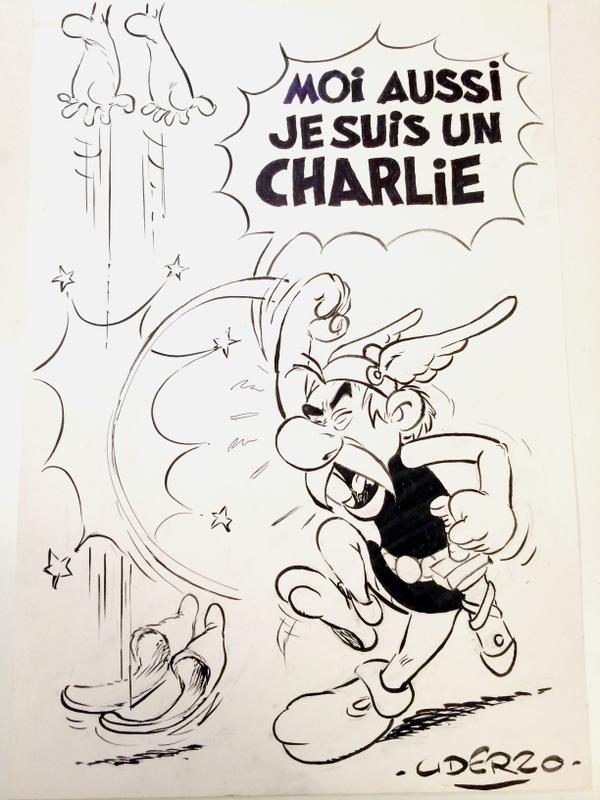
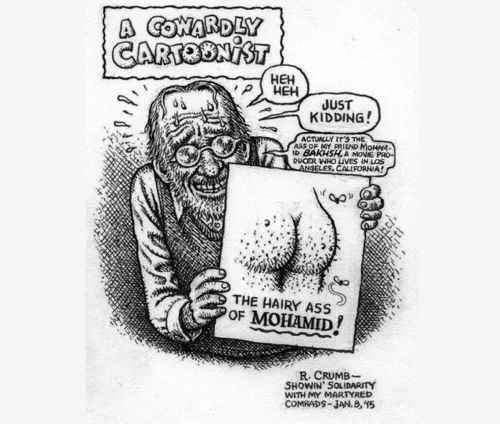
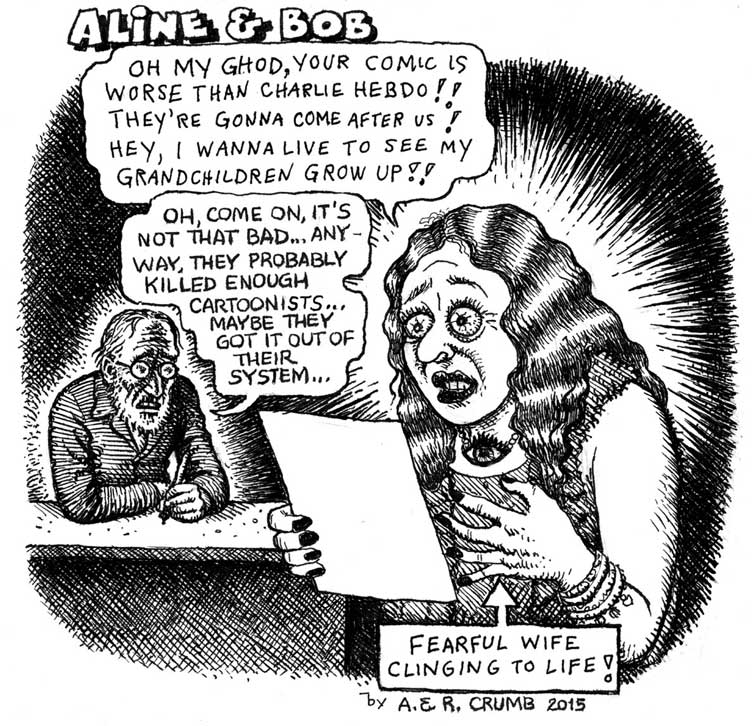
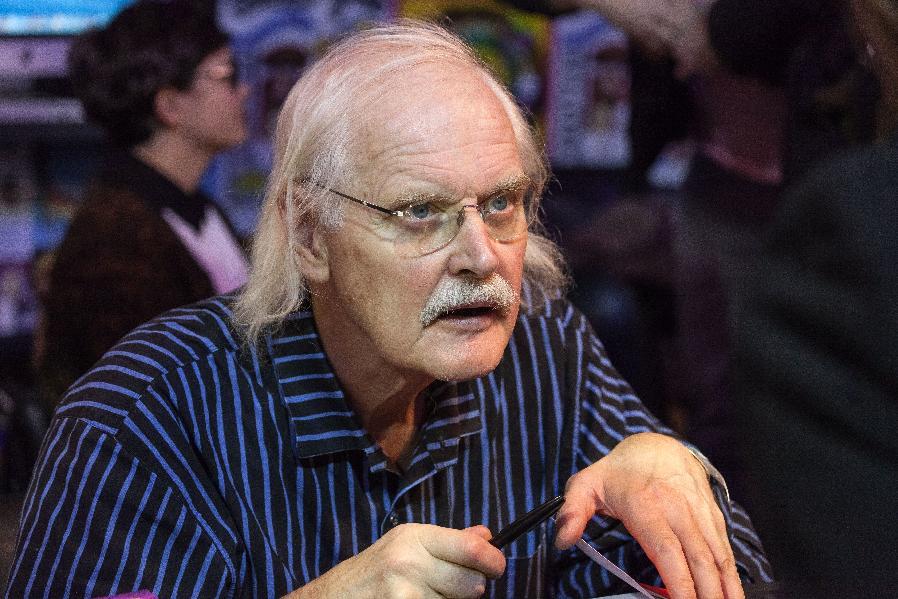
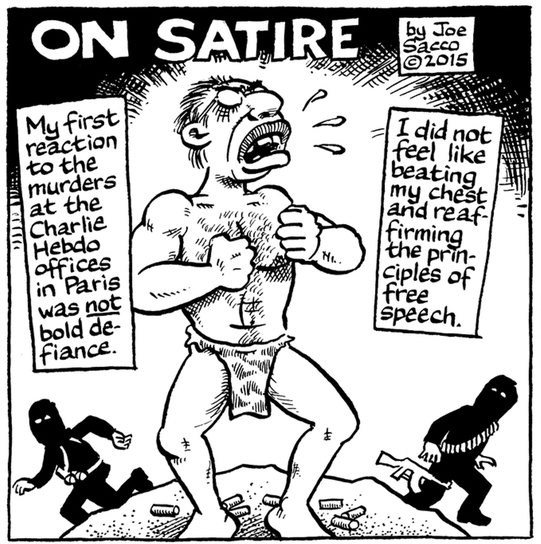
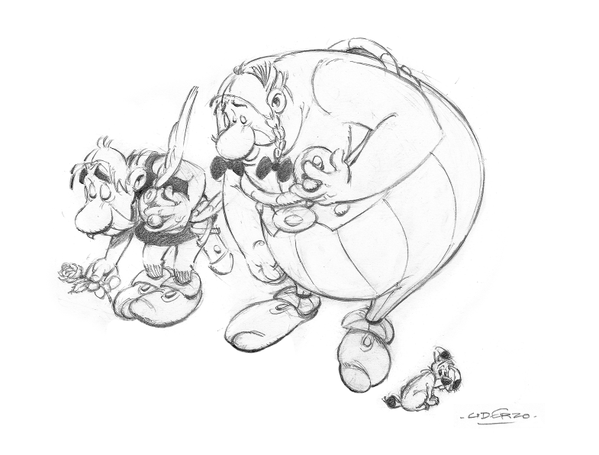

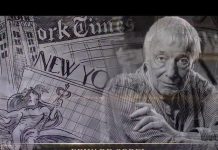




There’s too much there to go into, but for me, Joe Sacco’s cartoon is pretty spot-on.
I was very disappointed to see Uderzo’s first drawing followed up with the second. The first was one of grief and solidarity, the second… Asterix smashing foreigners out of his country, as is his wont; the eastern-style slippers signify it’s a Muslim, but there’s no weapons or other signs of it being a radical or terrorist – Asterix gives a Muslim everyman the forceful marching orders.
The touching gesture of the first cartoon turns into ham-fisted reactionary racism.
That Chad Parkhill piece is fantastic! Even though it’s written from an Australian perspective and I’m here in the US, it helped me understanding some aspects of the situation that I’ve been struggling to grasp. Thanks for the link!
“Joe Sacco’s cartoon in the Guardian warning against the dangers of reinforcing bigotry through satire has been widely seen and quoted. It’s a powerful argument against the anything goes attitude that Charlie Hebdo engaged in—an attitude which make many uncomfortable with the “Je suis Charlie” line.”
My main problem with Charlie H. is that it’s not very funny. Its heavy-handed, sledgehammer “satire” reminds me of some of the more strident underground comix from the Vietnam era. A Charlie cartoon showing a naked Mohammed on all fours (shown from behind) reminds me of some of the underground depictions of Nixon and LBJ.
Reports have said it was an atheist publication, staffed by people who hated all religions and had no interest in hearing other points of view. A cartoon showing rolls of toilet paper slugged “Koran,” “Bible” and “Torah” seems to bear this out.
Thre’s a history of “edgy satire” in this country, too. Crumb offended a lot of people with his depictions of blacks and women, and I recall an underground comic book called “Tits ‘N Clits,” which would probably result in protests and boycotts today.
Nobody deserves to die for publishing stuff like this. But I don’t feel comfortable with praising it, either.
The kind of satire that upsets people in the U.S. is the sort known as “politically incorrect.” The days when Richard Pryor put out albums called “That Nigger’s Crazy” and “Bicentennial Nigger” (with major label distribution) are over. Ditto for the days when Ralph Bakshi released “Coonskin.” The depiction of women as bimbos in “Caddyshack” and “Animal House” probably wouldn’t fly today, either.
On one hand, I miss the freewheeling, anything-goes satire of the ’70s and early ’80s. OTOH, I get uncomfortable when “edgy white guys” (like the ever-smug Seth McFarlane) defend their right to offend every group except their own crowd of hipsters. And I’m tired of smug white guys treating any complaint about their work as censorship.
Say what you want, guys, but don’t expect everyone to like it.
“edgy white guys” = most of the slain Charlie H guys.
Satire has it’s limits and can quickly lose it’s meaning, becoming something else/worse entirely.
Remember, satire is mockery.
“It’s an assertion of superiority over the other by way of debasing them. In the process of doing so, the humanity of the mocked is stripped away from them as they become an object of amusement.”
I don’t think childish cartoons that mock someone’s faith is worth all this craziness. You can’t go waving a red flag at a bull for years and then complain when he charges.
Whatever happened to common sense and good taste?
Why don’t I see people getting upset over Israel jailing the cartoonist Mohammad Saba’aneh for talking to a publisher in Jordan? Is it because he’s Muslim? Or because it’s Israel and the Western media like to shield them from criticism?
I think there’s a bit of a double standard here.
JE SUIS Saba’aneh!!!
I think Sight & Sound film critic Michael Pattison put it best, when he wrote:
“I can’t think of anything less progressive than championing ‘offensive art,’ especially the sort frequently perpetuated by the cartoonists at Charlie Hebdo. … Consider the absurdity, for instance, of defending an art that deliberately offends or ‘crosses the line’ on the black community, the working class community, the disabled community, the homosexual community and so on; there’s good reason why we call bullshit on such works. But two bampots kill 12 people one afternoon and suddenly we’ve got a hashtag claiming solidarity with satirists who, let’s be frank, weren’t very good or progressive or important to begin with (regardless of how ‘free’ they ought to be to ‘offend’ or ‘cross lines’).
“Implying that hornet’s-nest-kicking, lowest common denominator-appealing depictions of the Prophet Muhammad by white middle-class satirists was somehow important in its line-crossing is itself offensive, and the ‘Je Suis Charlie’ march that happened today in Paris is hypocritical horse-shit, featuring none other than a representative of the Saudi Arabian government, which two days ago dished out the first of its 50 lashings a week for 20 weeks, sentenced to a blogger for ‘insulting Islam.’ Ha!”
He’s right, of course. I doubt we’d applaud a publication that crudely lampooned black people, or Jews or Catholics or Asians or gays. We’d regard it as bigotry. But when a “newspaper” devotes itself to ridiculing Muslims, it’s taking a bold stand for “freedom.” Right.
It appears that freedom of speech in France is only for white people…
http://www.bbc.com/news/world-europe-30811401
Ah the But Brigade is out in full force trying to make it like Charlie Hebdo is partially responsible for being murdered by terrorists like good victim blammers.
Remember that New Yorker magazine cover that showed Michelle and Barack Obama as Muslim terrorists, with a picture of Bin Ladin on the wall and the American Flag in the fireplace? Do you think the New Yorker was being racists when they published that or were they commenting on racism?
If you guessed the latter you are correct. That type of cartooning is what Charlie Hebdo does, only they do it to a wide variety of subjects, including religions.
Honestly guys, it ain’t Charlie Hebdo’s fault if the terrorists couldn’t take a fucking joke okay? Nobody was forcing them to read the magazine.
Comments are closed.